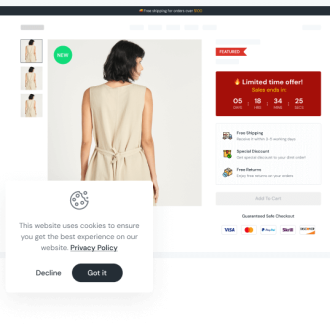Product data feed, also known as product feeds, are collections of items and their qualities that have been organized so that each product can be provided, promoted, or compared in a unique way.
So how do you keep your product data synced among all of these different sources? The answer typically involves some form of product data feed.
What is a product data feed?

A product no longer usually exists just on your e-commerce site these days. Your products may be listed in several locations in addition to your e-commerce website, including additional sales channels, product advertisements, affiliate websites, social networks, and more.
With the help of these strategies, you may increase the consumer base and reach of your business. So, how do we define a product data feed?
A product feed or product data feed is a file made up of a list of products and attributes of those products organized so that each product can be displayed, advertised, or compared in a unique way.
A product feed typically contains a product image, title, product identifier, marketing copy, and product attributes.
In short, a product data feed is made up of all the information required for the selected website to display your products.
What does a rich quality product data feed look like?

It must have a great deal of information, correct product details, and easily clear explanations. Customers can compare and buy your products with confidence when you provide them with enough relevant information and material.
Each channel has a set of requirements your product data feed needs to meet. Features like title construction, keyword-rich category paths/breadcrumbs, alternative images, and internal/external color keys and values are now fused into the core of basic product data feed requirements.
Title
The most important element of your product data feed is titles. Titles must be specific and different from those of your other products if you want increased conversions and accurate search results. The use of descriptive keywords in titles is now required.
Color
Always include standard and descriptive colors in the source online. Your products are relevant for consumer-used search terms, whether they are in titles or a color field.
Using your own standards rather than those of a straightforward consumer seeking the goods can reduce their visibility. Businesses have been known to use highly emotive colors in their product feeds.
Images
Users may scroll over your product if the images are of poor quality or unrealistic. Use a variety of realistic, high-quality photos to boost customer trust. Although it has little impact on product visibility, it can have an impact on your clicks and conversions.
Descriptions
Performance issues are made worse by poor descriptions. Optimized descriptions can influence clicks and conversions, although they are not as effective as a strong title.
Product categories
Simply put, boosting visibility requires that you use key phrases for your attributes and include them in your titles and descriptions. To help the channel understand your products, for example, add “duster coat” and “autumn” if you’re selling a cleaning coat in the autumn.
Categories
Retailers should try to stay away from using promotional language in their core category structure, such as “Sale,” “Discount,” “Less than £40,” and so on. Although helpful during busy times like Black Friday, it’s best to avoid categorizing items as raw.
Local Stock Data
Your local stock data needs to be updated as close to in-real-time as possible if you’re using LIAs to send customers to offline retailers. Customers can use it to choose which store to visit, and it helps the business avoid selling out-of-stock goods.
GTIN
Unless your product is unique, it needs one of these product identifiers, most commonly referred to as “barcodes.”
Remember
More data may be tested and changed at the source, increasing the chance that businesses will perform at their peak. The drive for more product information results in listings that are more detailed and informative.
Whichever channel you’re listing products to, category structure is important. Create categories for your products so that customers can find them with the fewest clicks possible, which is the objective.
Where can you use a product data feed?

Your product data can be shared in a variety of ways using a product feed, including:
Multi-channel
Selling your products on a third-party store, like Amazon, eBay, or Etsy, is what multi-channel product feeds include. By doing so, you can access the ecosystem of that store and its customer base directly.
Since they must include all the information necessary to complete the sale, such as inventory levels, prices, shipping details, and taxes, product feeds in this market can often be the most complicated.
Advertising
Displaying your products on another website, such as Facebook product Ads, Google Shopping, or Bing Shopping, is known as advertising product feeds. Pay-per-click (PPC) advertisements are common for them.
However, the lines have become a little unclear with the addition of buy button options, and in some product advertisements, you can now directly sell your product.
Social Media Sites
The posting of your product to platforms like Facebook, Twitter, and Pinterest involves using social media network product feeds.
You usually do not want to publish your whole product collection to each of these networks, unlike the other product feeds. It is preferable to slowly introduce fresh, relevant products that appeal to the followers in each of the important networks.
Affiliate Networks
A product data feed from affiliate networks is used to let affiliate sites advertise your products on their websites. Most affiliate items are Cost Per Action (CPA), which means you only pay if a sale is made.
Getting information to fill your product data feed

Making sure you have a strong, trustworthy source for your product data is the first step in creating a product data feed. The typical sources for product data are mentioned below, from the most user-friendly to the most challenging.
APIs
Many online shops, like Magento, Shopify, and BigCommerce, offer simple API access to your data. There is a certain level of developer engagement needed to connect to an API.
The ideal data source for a product feed is an API. APIs make it possible to access the data regularly and without having to make any educated guesses.
Databases
Using databases as a data feed source involves connecting directly to the database of your online store to collect the required information. Usually, this calls for a far more thorough connection with your e-commerce platform.
As a result, if the fundamental structure of your data changes, future updates to your e-commerce platform are more likely to break the data feed process.
Web crawling
The process of using a custom web crawler to search your shop for the required data on the web as a data feed source. It may take a lot more work upfront for this technique.
The HTML code for your store must contain all the data required for the feed. As you update your website, web spiders are also more likely to stop working.
Spreadsheets
The simplest method of obtaining product data is through a spreadsheet. This could be created manually or, in the worst situation, generated by the software used by your store. If your store has a significant inventory, a manual spreadsheet technique is not suitable and is going to require a lot of time.
In Conclusion
Your store may need to use product data flows for a variety of reasons, including advertising, multi-channel sales, and affiliate sales. There are more and more platforms for advertising your for-sale products as a result of the continuous growth of the e-commerce market.
Data feeds will almost certainly be used moving forward for any cross-promotion of the products in your business. You can greatly simplify this process for yourself in the future by taking the time to plan out a strong product data feed strategy for your store.



